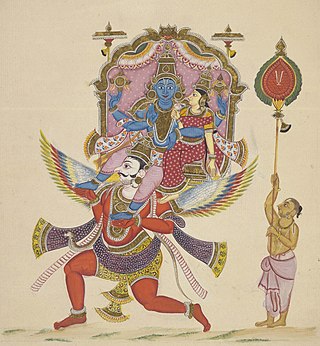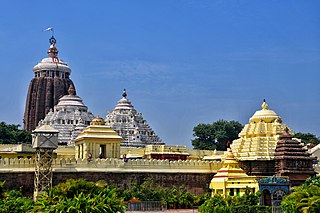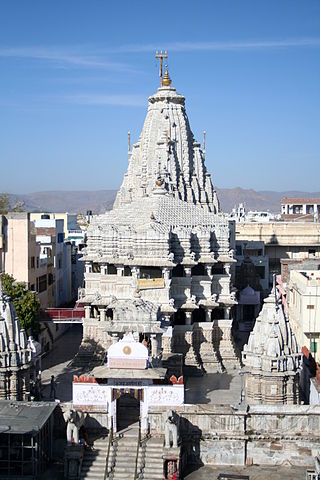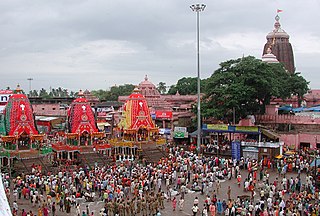Related Research Articles

Jagannath is a deity worshipped in regional Hindu traditions in India and Bangladesh as part of a triad along with his brother Balabhadra, and sister, Subhadra. Jagannath, within Odia Hinduism, is the supreme god, Purushottama, and the Para Brahman. To most Vaishnava Hindus, particularly the Krishnaites, Jagannath is an abstract representation of Krishna, or Vishnu, sometimes as the avatar of Krishna or Vishnu. To some Shaiva and Shakta Hindus, he is a symmetry-filled tantric form of Bhairava, a fierce manifestation of Shiva associated with annihilation.

Trimbakeshwar Shiva Temple is an ancient Hindu temple in the town of Trimbak, in the Trimbakeshwar tehsil in the Nashik District of Maharashtra, India, 28 km from the city of Nashik and 40 km from Nashik road. It is dedicated to Hindu god Shiva and is one of the twelve jyotirlingas where the Hindu genealogy registers at Trimbakeshwar, Maharashtra are kept. The origin of the sacred Godavari river is near Trimbak.

Lakshmi Narayana or Lakshmi Narayan is the dual representation of the Hindu deities Vishnu, also known as Narayana, and his consort, Lakshmi, traditionally featured in their abode, Vaikuntha. The goddess of prosperity and beauty, Lakshmi, is depicted as standing next to Vishnu, who holds the Panchajanya, Kaumodaki, Padma, and the Sudarshana Chakra. Another depiction of Lakshmi-Narayana portrays Lakshmi in the service of Narayana, who reclines on the cosmic serpent Shesha, floating in the Kshira Sagara, the Ocean of Milk.

The Jagannath Temple is an important Hindu temple dedicated to Jagannath, a form of Vishnu – one of the trinity of supreme divinity in Hinduism. Puri is in the state of Odisha, on the eastern coast of India. The present temple was rebuilt from the tenth century onwards, on the site of pre-existing temples in the compound but not the main Jagannatha temple, and begun by Anantavarman Chodaganga, the first king of the Eastern Ganga dynasty.

Thrikkakara Vamanamoorthy Temple is one of the few Hindu temples in India dedicated to Lord Vamana/Vishnu. It is situated in Thrikkakara, Kochi in the state of Kerala, India. Located around 10 km north-east of the city center between Thrissur-Ernakulam highway, Seaport-Airport Road, Cochin University of Science and Technology and Model Engineering College, it is a centre of celebrations and a place of origin for the popular Onam festival. The temple is around two millennia old and is also listed as one of the 108 Divya Desams.

Malayappa Swami is the current utsava murti in the Tirumala Venkateswara Temple, Tirumala. Malayappa Swami is worshipped during religious ceremonies and processions wherein it would be inappropriate to use the main deity. The two deities are worshipped equally and believed to be non-different in personality.

Tirumala Krishna idol is one of the idols in the Tirumala Venkateswara Temple, Andhra Pradesh, India. While the temple is dedicated to worship of lord Vishnu as Venkateswara, it contains the idols of some of Vishnu's other avatars - Krishna and Rama. The temple also has the idol of Rukmini, wife of Lord Krishna.

The Maa Sarala Temple is a Hindu temple in the district of Jagatsinghpur, Odisha, India. It is one of the eight most famous Shakta shrines of Odisha.
This article lists the traditional festivals and other cultural events in the Odisha region of India. Odisha celebrates 13 festivals in 12 months as the saying goes Bāra Māsare Tera Parba.

Mahavinayak Temple is a major pilgrimage center in Chandikhole in Jajpur district in the Indian state of Odisha. It is one of the oldest Ganesha temples in the state. Five gods - Shiva, Vishnu, Durga, Sun and Ganesha - are worshiped as one deity in a single Garbhagriha or sanctum sanctorum there.

The Biraja Temple, or Birija Kshetra, is a historic Hindu temple located in Jajpur, Odisha, India. The present temple was built during the 13th century. The principal idol is Devi Durga, who is worshiped as Viraja (Girija), and the temple gave Jajpur the nicknames "Viraja Kshetra" and "Biraja Peetha". The Durga idol has two hands (dwibhuja), spearing the chest of Mahishasura with one hand and pulling his tail with the other. One of her feet is on a lion, and the other is on Mahishasura's chest. Mahishasura is depicted as a water buffalo. The idol's crown features Ganesha, a crescent moon and a lingam. The temple covers a large area, and has several shrines to Shiva and other deities. According to the Skanda Purana it cleanses pilgrims, and it is called the Viraja or the Biraja kshetra. Jajpur is believed to have about one crore of Shiva lingams.

Janardana Swami Temple is a 2000+ year-old temple situated in the municipality of Varkala city in Trivandrum. It is also known as Varkala Temple. Janardana Swami is a form of Lord Vishnu. It is a very well known temple in Kerala about 10.9 km west of Kallambalam on NH 66 near sea, 25 km north of Thiruvananthapuram city, 8 km south of famous backwater destination Kappil and 2 km from Varkala Railway Station,14 km north west of Attingal municipality. It is situated near the Arabian sea shore.It is referred to as Dakshin Kashi. The temple is located close to the Varkala Beach, which is considered to have medicinal properties since the waters wash the nearby medicinal plants. It is also an important Ayurveda treatment center. The temple has an ancient bell removed from a shipwreck, donated by the captain of the Dutch vessel which sank near Varkala without causing any casualties.

Jagdish Temple is a large Hindu temple in the middle of Udaipur in Rajasthan, just outside the royal palace. It has been in continuous worship since 1651. A big tourist attraction, the temple was originally called the temple of Jagannath Rai but is now called Jagdish-ji. It is a major monument in Udaipur.

Sri Lakshmi Varaha Swamy Temple is a 500-year-old Indian temple dedicated to Varaha, the boar incarnation of Vishnu.

Ratha Yatra, or Car festival, is any public procession in a chariot. The term particularly refers to the annual Ratha Yatra in Odisha, Jharkhand, West Bengal and other East Indian states, particularly the Odia festival that involve a public procession with a chariot with deities Jagannath, Balabhadra, Subhadra and Sudarshana Chakra on a ratha, a wooden deula-shaped chariot. Ratha Yatra processions have been historically common in Vishnu-related traditions in Hinduism across India, in Shiva-related traditions, saints and goddesses in Nepal, with Tirthankaras in Jainism, as well as tribal folk religions found in the eastern states of India. Notable Ratha Yatras in India include the Ratha Yatra of Puri, the Dhamrai Ratha Yatra and the Ratha Yatra of Mahesh. Hindu communities outside India, such as in Singapore, celebrate Ratha Yatra such as those associated with Jagannath, Krishna, Shiva and Mariamman. According to Knut Jacobsen, a Ratha Yatra has religious origins and meaning, but the events have a major community heritage, social sharing and cultural significance to the organizers and participants.

The Kurmanathaswamy temple, also known as the Kurmanatha temple, Srikurma or Srikurmam temple, is a Hindu temple dedicated to Kurma – the second avatar of Vishnu. It is located in Srikurmam village, Srikakulam district in Andhra Pradesh, India. According to Prapannamrutam and earliest inscription of the temple, In saka 1035 CE Anantavarman Chodaganga Deva of Eastern Ganga Dynasty of Odisha converted this temple to a Vaishnava khetra from a Siva temple.The temple was Built before 11th-century AD in a fusion architecture of kalinga Architecture and Dravidian Architecture. The temple's perambulatory were constructed by Eastern Ganga Dynasty king Anangabhima Deva III , and it is dedicated to Vishnu as Kurmanathaswamy and his consort Lakshmi as Kurmanayaki. The temple has century old Orissan Pattachitra style mural paintings in side wall of pradakshina mandapa.

Venkateswara Temple is a Vaishnavite temple situated in the town of Dwaraka Tirumala of Eluru district of the Indian state of Andhra Pradesh. The temple is dedicated to Lord Venkateswara, an incarnation of Vishnu. The temple is also known by other name like Chinna Tirupati meaning Small Tirupati.
References
- ↑ "Singhapur Yatra: Lord to emerge from pond". IBN Live. Archived from the original on 11 April 2013. Retrieved 8 July 2013.
- ↑ "Idol of deity comes alive - Lord Narayan Gosain appears from underwater abode". The Telegraph. 14 April 2011. Archived from the original on April 11, 2013. Retrieved 8 July 2013.
Coordinates: 20°48′59″N86°08′00″E / 20.816467°N 86.133338°E